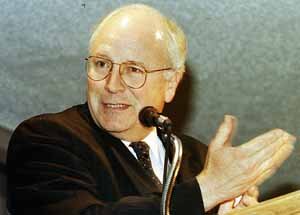Members of “The PNAC Gallery”, Joshua Bolten, Karen Hughes, Condoleezza Rice, I. Lewis ‘Scooter’ Libby and Dick Cheney. [Source: David Bohrer / White House]
Now let’s follow that bouncing ball, sometimes called Dick Cheney, a bit further. In September 2000 Cheney signed his name before his selection as George W. Bush’s vice presidential running-mate, to an unusual think-tank report that became the de facto blueprint of US military and foreign policy to the present.
Another signer of that report was Don Rumsfeld, who would become Defense Secretary under the Cheney-Bush presidency (the order reflects the reality–w.e.)
The think-tank, Project for a New American Century (PNAC), was financed by the US military-industrial complex, supported by a gaggle of other Washington neo-conservative think tanks such as RAND.
The PNAC board also included neo-conservative Paul Wolfowitz, later to be Rumsfeld’s Deputy Secretary of Defense; ‘Scooter Libby,’ later Vice President Cheney’s Chief of Staff.
It included Victoria Nuland’s husband, Robert Kagan. Notably Victoria Nuland herself went on in 2001 to become Cheney’s principal deputy foreign policy adviser. It included Cheney-Bush ambassador to US-occupied Afghanistan and Iraq, Zalmay Khalilzad, and hapless presidential candidate Jeb Bush.

Zionist agents of the Project for a New American Century (PNAC) planned and executed the annihilation of Iraq
Cheney’s PNAC report explicitly called on the future US President to remove Iraq’s Saddam Hussein and militarily take control of the Middle East a full year before 911 gave the Cheney-Bush Administration the excuse Cheney needed to invade Iraq.
The PNAC report stated that its recommendations were based on the report in 1992 of then-Secretary of Defense, Dick Cheney:
“In broad terms, we saw the project as building upon the defense strategy outlined by the Cheney Defense Department in the waning days of the Bush Administration. The Defense Policy Guidance (DPG) drafted in the early months of 1992 provided a blueprint for maintaining U.S. preeminence, precluding the rise of a great power rival, and shaping the international security order in line with American principles and interests.”
At a time when Iran as a putative nuclear “threat” was not even on the map, PNAC advocated Ballistic Missile Defense: “DEVELOP AND DEPLOY GLOBAL MISSILE DEFENSES to defend the American homeland and American allies, and to provide a secure basis for US power projection around the world. (emphasis added)
In the report Cheney’s cronies further noted that, “The military’s job during the Cold War was to deter Soviet expansionism. Today its task is to secure and expand the “zones of democratic peace; (sic)” to deter the rise of a new great-power competitor; defend key regions of Europe, East Asia and the Middle East; and to preserve American preeminence…”
The Cheney PNAC document of 2000 went on:
“The United States has for decades sought to play a more permanent role in Gulf regional security. While the unresolved conflict with Iraq provides the immediate justification, the need for a substantial American force presence in the Gulf transcends the issue of the regime of Saddam Hussein.“
_________
The quote is worth reading at least twice

“Now you two are sure this is going to work, right?”
A year after the PNAC report was issued, then-General Wesley Clark, no peacenik to be sure, in a March 2007 speech before the Commonwealth Club of California in San Francisco, told of a Pentagon discussion he had had shortly after the strikes of September 11, 2001 at the World Trade Center and Pentagon with someone he knew in Defense Secretary Rumsfeld’s office.
Ten days after the 911 attacks, Clark was told by the former Pentagon associate, a general, that the Pentagon planned to invade Iraq. This was when Osama bin Laden, a bitter foe of the secular Baathist Socialist, Saddam, was being blamed for the terror attacks, and there was no 911 link to Iraq’s government.
Clark related his conversation that day with the general:
“We’ve made the decision we’re going to war with Iraq.” This was on or about the 20th of September. I said, “We’re going to war with Iraq? Why?” He said, “I don’t know.” He said, “I guess they don’t know what else to do.” So I said, “Well, did they find some information connecting Saddam to al-Qaeda?” He said, “No, no.” He says, “There’s nothing new that way. They just made the decision to go to war with Iraq.”
“I came back to see him a few weeks later, and by that time we were bombing in Afghanistan. I said, “Are we still going to war with Iraq?” And he said, “Oh, it’s worse than that.” He reached over on his desk. He picked up a piece of paper. And he said, “I just got this down from upstairs” — meaning the Secretary of Defense’s office — “today.” And he said, “This is a memo that describes how we’re going to take out seven countries in five years, starting with Iraq, and then Syria, Lebanon, Libya, Somalia, Sudan and, finishing off, Iran.”
These were all wars, or attempted wars from the US for military control of the most abundant proven oil regions of the world, what Cheney in 1999 described as, “where the prize ultimately lies.”
Since that time, the US State Department and a host of government-tied NGO’s such as National Endowment for Democracy, Freedom House, Soros’ Open Society Foundations and others, along with the CIA, have launched the US-orchestrated (“lead from behind” is the current slogan) Arab Spring series of “democratic” regime coups across the Middle East, including Hillary Clinton’s war against Qaddafi in Libya, against Bashar al Assad in oil-and-gas-rich Syria, in Iraq yet again, Egypt and other oil or gas states of the Middle East, including an failed 2009 Color Revolution, the so-called “Green Revolution” in Iran.
_________
US Agenda in the Mideast

“Oh John, do you really think we can get a war started again?”
The Washington Pentagon and US State Department agendatoday in the Middle East has not varied one bit from that described by General Clark about his September 20 2001 Pentagon talk.
It has expanded, but the aim is the same: full US military control of the heart of world oil flows, the Persian Gulf and beyond. As Henry Kissinger is alleged to have said during the first oil shock of the early 1970’s (which he was instrumental in making happen), “If you control the oil, you control entire nations or groups of nations.”
Here we come to the September, 2014 Kerry-Abdullah deal. Washington ultimately has her eye on controlling the Saudi monarchy and its vast oil reserves, along with those of Kuwait and other Gulf Cooperation Council US “allies.” Britain, whom Charles de Gaulle referred to as “perfidious Albion,” is not the only perfidious world power.
After major surprises in their 2014 strategy of killing Russia’s oil revenue with Saudi help, when their own booming oil shale industry began to face major company bankruptcies, Washington was forced to recalculate. When Russia made its surprise entry into Syria on invitation of her legitimately elected President, Assad, on September 30, 2015, Washington was forced again to recalculate.
Now the new plan seems to be to give Saudi Arabia “enough rope to hang herself” as that Soviet hangman, V. I. Lenin, was fond of saying.
When Prince Salman, the de facto Saudi King, fired the architect of Abdullah’s oil strategy to destroy US shale and regain world oil hegemony earlier this year and replaced him by ARAMCO chairman, Khalid Al-Falih, someone said to be more compliant with the 31-year-old erratic Prince Salman. Khalid immediately announced no plan to alter the low price high-production strategy of the Kingdom in order to kill the US shale rivals, despite mounting evidence the world oil market had undergone profound change since 2014.
It seems, however, that the US shale producers are far more resilient than the wily Prince Salman has calculated.
On April 26, in testimony before the US Senate Energy and Natural Resources Committee’s “Hearing to examine challenges and opportunities for oil and gas development in different price environments,” Suzanne Minter, Manager, Oil and Gas Consulting at Platts’ Analytics presented pretty interesting details that help explain why the volume of US shale oil has not yet collapsed despite a fall in global oil prices from around $103 a barrel in September 2014 to a range of $40-50 a barrel today.
Most shale projects were to have gone under at prices below $65 or thereabouts.
In her testimony, Minter described extraordinary technology changes that have allowed US shale oil producers to survive and more. She noted that since 2012 US oil production grew by 57% from 6.1 million barrels per day (mmb/d) to a peak of 9.7 MMB/d in April of 2015. Almost all was due to new shale oil output. That’s 3.6 million barrels of US shale oil a day, a huge volume for the world oil market, including Saudi Arabia, to deal with.
Minter described the effects of huge technology improvements using the Texas Eagle Ford Basin shale region as an example:
“Currently the Eagle Ford accounts for 13% of US crude production. In October, 2014 the rig count in the Eagle Ford peaked at 209 rigs. At that time, the average initial production (IP) rate for a well in the Eagle Ford was 436 barrels of crude per day and the average time it took to drill a well was 15 days. At that time, those 209 rigs, should they have remained in the basin, and continued to drill at that rate of one well every 15 days, would have ultimately produced 3.3 MMB/d of crude in the Eagle Ford by 2020.”
Then she describes the technology gains in production as well as time to drill and how many wells needed to get the same shale oil output. It’s impressive:
“In 2015 as producers cut their rig fleets, the rigs remaining now sit on the best known acreage. Resultantly, the average IP rate in the Eagle Ford increased by 50% to 662 barrels of crude per day and average drill times have fallen by 25% to 11 days. As a result, the current rig count of 49 in the Eagle Ford could theoretically hold production flat at the current estimated level of 1 MMb/d, so long as those 49 rigs stay in the basin through 2020 and continue to drill one well each every 11 days with an IP rate of 662 barrels each. This also means, that when recovery occurs, the Eagle Ford would only require 125 rigs to create the 3.3 MMB/d previously projected by 2020 that had once required 209 rigs to produce.”

US Marine near Rutbah, western Iraq, 2005
Minter continued, “The time and the rate in which this energy entered the market appears to have stressed the system in ways unimagined” making the US producer, “the marginal supplier and price setter into the global market.”
The Platts oil expert continued, “Drilled but uncompleted wells hold reserves that can be brought on line in a short period of time, thereby defining the concept of spare capacity. It is plausible to believe that US spare capacity may be close to rivaling OPEC’s current spare capacity. However, we believe that the prices needed to incentivize the US producer to complete their drilled but uncompleted wells may be much lower than global competitors believe or would like it to be. (emphasis added). Minter concluded, “Texas alone could introduce 1.25 MMB/d of oil into the global market and can do so in a short space of time – on average just 30 days. That’s more oil than the Saudis have threatened to flood the market with.”
So poor Prince Salman and his Royals may soon face an internal revolt by jealous and angry Royal rivals for destroying the finances of the once-super-rich Saudi Kingdom. The only fly in the US shale oil soup, however, is how long the shale oil bonanza can last. Shale oil reservoir depletion rates are significantly faster that with conventional wells.
Some estimate that shale volumes in the US will drop dramatically, despite the new technologies, within five or so years. But by then Washington’s foolish Pentagon planners hope to have locked the entire Persian Gulf into their military grip, including the foolish Saudis. Both sides have a mad agenda.
 Welcome to the flying dining room with lizard green chairs- Saudi style
Welcome to the flying dining room with lizard green chairs- Saudi style Kerry with the late King Abdullah
Kerry with the late King Abdullah Cheney 1998
Cheney 1998![Dick Cheney in the White House bunker, speaking to administration officials (from left) Joshua Bolten, Karen Hughes, Condoleezza Rice and I. Lewis ‘Scooter’ Libby. [Source: David Bohrer / White House]](http://www.veteranstoday.com/wp-content/uploads/2011/10/cheney_bunker_crowd_-320x169.jpg)








No comments:
Post a Comment